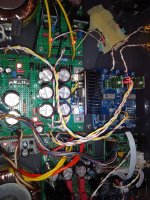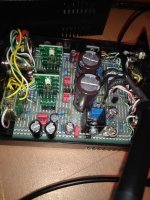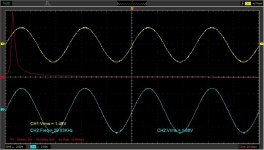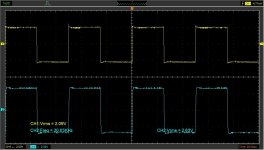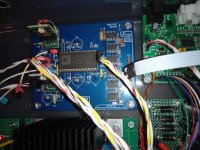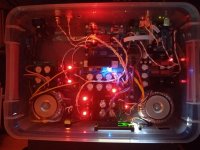We tried a simmilar adapter on PCM63 and AD1865, and it should work on all others. Miro seems to have used the same I/V circuit layout for all of them.
PCM63, AD1862, AD1865 have the same I/V placement, the exception is TDA1541 and TDA1540 (no offset, but the I/V placement is wider) 😊
Chinese single channel discrete OPAs. Bought just to try. The measurement is satisfactory, now I'm going to hear how they play. DC offset below 2mV in Line preamp. Frequency range in Line preamp 700kHz -3dB on load 20k+360pF. I don't see THD on the FFT. They consume some current, I can see that they heat up and quickly empty the electrolytes in the power supply when it turns off. Prices around $18 for a pair of single OPAs.
I put them into the Miro AD1856 DAC, listening and comparing follows. To begin with, they are not Sparkos SS3601, but their sound changes gradually, they are not bad in general. They obviously need some brake-in time for full potential.
They even glow in the dark for that money. 🤣
https://www.aliexpress.com/item/100...!sea!SRB!711124452&curPageLogUid=IpuPCd5uTR6J
I put them into the Miro AD1856 DAC, listening and comparing follows. To begin with, they are not Sparkos SS3601, but their sound changes gradually, they are not bad in general. They obviously need some brake-in time for full potential.
They even glow in the dark for that money. 🤣
https://www.aliexpress.com/item/100...!sea!SRB!711124452&curPageLogUid=IpuPCd5uTR6J
Attachments
Last edited:
I started listening a little earlier tonight, I found time. Burson V5 is better than Nvarcher. OPA1641A is better in this DAC (AD1856) than both Burson and Nwarcher. Why the 1641A stands out so much in this dak, I really have no idea. Something suits it. Nvarcher has a slightly softer and more fluid sound, it is not excluded that it fits better in some other system. The OPA1641A has a tighter sound, everything is better defined with that OPA than with the others. I'm going to continue harassing this Nwarcher a little longer, to see if anything changes.
They also have other, more expensive and more complex models of discrete OPAs, you just need to know which ones are good, and there is little data on how good or bad they are.
They also have other, more expensive and more complex models of discrete OPAs, you just need to know which ones are good, and there is little data on how good or bad they are.
I recently bought on ebay this AD1865N used, produced in 1991 in Phillipines. Price $25 + $6. So I said give it a quick try while I can still claim a refund. The testing was interesting. I couldn't believe it right away, but the OPA1641A in this DAC gave a somewhat artificial sound, dry and uninteresting. In contrast, the Nvarcher Chinese discrete OPA simply flourished in this combination with the AD1865N. I find it extremely intriguing why it was completely different with the AD1856, where the OPA1641A dominated? I haven't had time to test the other OPAs, will do so later. The AD1865 is a much better DAC than the AD1856. It also works well at 384kHz sampling rate. 😎
Attachments
Miro, sorry to bother you, where is the latest version of the gerbers for AD1862 with shift registers, I need that one (and schematic too).
It's ordered - don't worry.🤓Miro, sorry to bother you, where is the latest version of the gerbers for AD1862 with shift registers, I need that one (and schematic too).
Saving the best for last! 🤣Miro, sorry to bother you, where is the latest version of the gerbers for AD1862 with shift registers, I need that one (and schematic too).
But, is there ever an end to the “last one”? 😁
Well, I'm not going to do that, I'm taking this for others, I'll leave one kit for myself, for retirement, and then I'll do it. I've made enough for now. 😎
@NIXIE62 Find: "Use damping resistors" on this website https://www.allaboutcircuits.com/te...ate-reflection-noise-in-your-next-pcb-design/ 😊 (maybe it is useless for this application, but ...)
I experimented without them. In fact, without the entire section behind them. Direct I2S wire to the resistor holes. I have the best result with silver solid core - AWG 23 - 0.573mm. I still have to try shielding silver wire - instead of ribbon cable or ufl. But the material is not so important as the thickness of the wire. AWG 24 is fairly neutral but misses a little bit on the top end and a little bit on the bottom end AWG 20 will start to sound a bit rich and possibly bass heavy. AWG 23 have the additional weight I was looking for, and it hasnt come at the expense of the top end, which has nice clarity and no edge.but ...
I think that all this should be checked with an oscilloscope to see what is really happening on I2S lines.
The difference is incredible for me without the resistors there. I have no idea why. I don't have an oscilloscope.
- Home
- Source & Line
- Digital Line Level
- DAC AD1862: Almost THT, I2S input, NOS, R-2R
